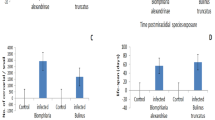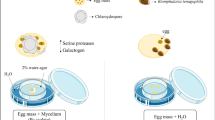Abstract
Growth, egg laying rate, and mortality ofBiomphalaria glabrata (Portorican strain), maintained in groups of two, after exposure at different ages (1, 2, 4, 6, 8 weeks) to three miracidia each ofSchistosoma mansoni (Liberian strain) were determined. The findings in infected snails were compared with those in exposed but uninfected (negative) and in unexposed snails. Younger snails were infected at higher rates, and these showed a significantly increased mortality. Young infected snails grew much slower than negative or unexposed snails; older infected snails grew at about the same rate as negative or control snails. A growth acceleration was not observed in parasitized animals. When prepatency to a high extent passed before sexual maturity, infected snails did not lay any eggs. In later infections the numbers of eggs dropped below those in healthy snails by the second week after exposure. Snails were dissected 15 weeks after exposure. Development of male reproductive organs (prostate gland, preputium plus penis sheath), in relation to shell diameter, was retarded particularly in animals infected before sexual maturity and highly retarded in growth. In larger animals the organs reached approximately their definitive size. Parasitized snails were partially deformed by an enlargement of their shell apertures on the right side.
Zusammenfassung
Nach Exposition gegenüber 3 Miracidien vonSchistosoma mansoni (Liberianischer Stamm) in verschiedenem Alter (1, 2, 4, 6, 8 Wochen) wurden an zu zweit gehaltenen Schnecken vonBiomphalaria glabrata (Portorico-Stamm) Wachstum, Eiablage und Mortalität bestimmt. Die Befunde an infizierten Schnecken wurden mit denen negativ gebliebener und nicht exponierter Schnecken verglichen. Jüngere Schnecken ließen sich in höherem Maße infizieren, starben aber auch signifikant mehr als negative oder unexponierte; älter infizierte unterschieden sich kaum von den Kontrollen oder negativen. Wachstumsacceleration parasitierter Tiere wurde nicht beobachtet. Lag die Präpatenz überwiegend vor Eintritt der Geschlechtsreife, so legten die infizierten Schnecken keine Eier ab. Bei späteren Infektionen sank die Zahl der abgelegten Eier schon ab der 2. Woche nach Infektion unter die der gesunden Tiere. 15 Wochen nach der Infektion wurden die Tiere seziert. Eine verzögerte Entwicklung männlicher Geschlechtsorgane (Prostata, Präputium mit Penisscheide), bezogen auf den Gehäusedurchmesser, wurde vor allem bei Tieren gefunden, die vor der Geschlechtsreife infiziert worden waren. Bei größeren Tieren erreichten die Organe annähernd die normale Endgröße. Bei einem Teil der parasitierten Tiere verformte sich das Gehäuse durch Mündungserweiterung an der rechten Seite.
Similar content being viewed by others
References
Becker W (1980) Metabolic interrelationship of parasitic trematodes and molluscs, especiallySchistosoma mansoni inBiomphalaria glabrata. Z Parasitenkd 63:101–111
Boettger CR (1953) Größenwachstum und Geschlechtsreife bei Schnecken und pathologischer Riesenwuchs als Folge einer gestörten Wechselwirkung beider Faktoren. Zool Anz (Suppl) 1953:468–587
Etges FJ, Gresso W (1965) Effect ofSchistosoma mansoni infection upon fecundity inAustralorbis glabratus. J Parasitol 51:757–760
Harry HW (1965) Evidence of a gonadal hormone controlling the development of the accessory reproductive organs inTaphius glabratus (SAY) (Gastropoda, Basommatophora). Trans Am Microsc Soc 84:157
Joosse J (1980) Endocrinology of reproduction in basommatophoran pulmonate snails. Haliotis 10:72
Looker DL, Etges FJ (1979) Effect ofSchistosoma mansoni infection on fecundity and perivitelline fluid composition inBiomphalaria glabrata. J Parasitol 65:880–885
McClelland G, Bourns TKA (1969) Effects ofTrichobilharzia ocellata on growth, reproduction and survival ofLymnaea stagnalis. Exp Parasitol 24:137–146
Meier-Brook C (1976) An improved relaxing technique for molluscs using pentobarbital. Malacol Rev 9:115–117
Meuleman EA (1972) Host-parasite interrelationships between the freshwater pulmonateBiomphalaria pfeifferi and the trematodeSchistosoma mansoni. Neth J Zool 22:355–427
Neuhaus W (1940) Parasitäre Kastration beiBithynia tentaculata. Z Parasitenkd 12:65–77
Neuhaus W (1949) Hungerversuche zur Frage der parasitären Kastration beiBithynia tentaculata. Z Parasitenk14:300–319
Newton WL (1953) The inheritance of susceptibility to infection withSchistosoma mansoni inAustralorbis glabratus. Exp Parasitol 2:242–257
Pan C-T (1965) Studies of the host-parasite relationship betweenSchistosoma mansoni and the snailAustralorbis glabratus. Am J Trop Med Hyg 14:931–976
Perlowagora-Szumlewicz A (1968) The reaction ofAustralorbis glabratus (Biomphalaria glabrata) to infection withSchistosoma mansoni. Rev Inst Med Trop Sao Paulo 10:219–228
Richards CS (1973) Susceptibility of adultBiomphalaria glabrata toSchistosoma mansoni infection. Am J Trop Med Hyg 22:748–756
Sluiters JF (1978) The effects ofTrichobilharzia ocellata infection on the development of the gonad and the reproductive tract ofLymnaea stagnalis. Short communication. 4th Int Congr Parasitol Warsaw, Sect F:20
Sluiters JF, Brussaard-Wüst CM, Meuleman EA (1980) The relationship between miracidial dose, production of cercariae, and reproductive activity of the host in the combinationTrichobilharzia ocellata andLymnaea stagnalis. Z Parasitenkd 63:13–26
Standen AD (1951) Some observations upon the maintenance ofAustralorbis glabratus in the laboratory. Ann Trop Med Parasitol 45:80–85
Sturrock BM (1966) The influence of infection withSchistosoma mansoni on the growth rate and reproduction ofBiomphalaria pfeifferi. Ann Trop Med Parasitol 60:187–197
Sturrock BM, Sturrock RF (1970) Laboratory studies of the host-parasite relationship ofSchistosoma mansoni andBiomphalaria glabrata from St. Lucia, West Indies. Ann Trop Med Parasitol 64:357–363
Thomas JD, Benjamin M (1974) The effects of population density on growth and reproduction ofBiomphalaria glabrata. (Gastropoda: Pulmonata). J Anim Ecol 43:31–50
Wilson RA, Denison J (1980) The parasitic castration and gigantism ofLymnaea truncatula infected with the larval stages ofFasciola hepatica. Z Parasitenkd 61:109–119
Wright CA (1971) Flukes and snails. George Allen and Unwin, London, pp 1–168
Author information
Authors and Affiliations
Rights and permissions
About this article
Cite this article
Meier, M., Meier-Brook, C. Schistosoma mansoni: Effect on growth, fertility, and development of distal male organs inBiomphalaria glabrata exposed to miracidia at different ages. Z. Parasitenkd. 66, 121–131 (1981). https://doi.org/10.1007/BF00925719
Received:
Issue Date:
DOI: https://doi.org/10.1007/BF00925719




